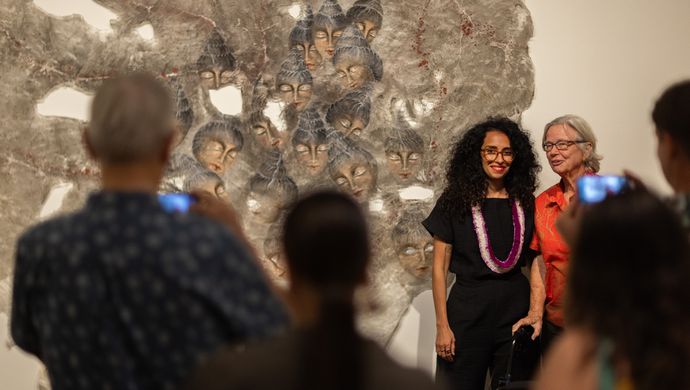 Interview
Interview
5 questions: Kenyatta Kelechi
Kelechi’s mother is Hawaiian, Chinese, and Caucasian, while his father is African American, French, and Native American, hailing from New Orleans. And though Kelechi grew up in Kailua, “there were times I felt like an outsider to Hawaiian culture,” he says. “It made me wonder who I am and where do I fit in all of this.”
He searched for a way into his culture and found it through the tricky 19th-century photographic process known as wet-plate collodion. Labor intensive, wet-plate photography involves chemicals and quick timing. Matthew Brady used this technique for his historic photographs of the Civil War.
Now working on a body of work that sees him making photographs of Kanaka ‘Ōiwi cultural practitioners, Kelechi feels “these people should be photographed in a [way] that requires a process, because what they do requires a process. Every single thing that Indigenous people do requires hard work and labor. So [wet-plate] is appropriate, it matches.”
Looking at his portrait of alaia (traditional wood surfboard) shaper Bronson Lovell might bring to mind the iconic ca. 1898 image of Charles Kauha in Waikīkī. He wears a malo and holds an alaia with Lē‘ahi in the background. Taken by Frank Davey, the photo (an albumen print, not wet-plate) can be read as exoticization and was likely staged and created to make money. Art as exploitation. Kelechi flips the colonial equation, as a Native Hawaiian connecting to and celebrating cultural torch bearers like Lovell.
Kelechi took the time to answer five questions about his work. This interview has been edited for clarity.
How did you learn the technique of colloidal wet-plate photography?
I did some research on the internet and found some videos on YouTube and some books—it was a mixture of all three and a lot of trial and error.
Were you doing digital photography before learning wet-plate photography?
No. I was taking analog photography classes at UH. I was already committed to the BFA program there, and photography was the [medium] that stuck with me the most.
Where did you find your camera?
Surprisingly enough I found it on eBay. I think it’s from around 1915. It’s pretty old.
There are many cultural practitioners doing incredible work. How do you select your subjects?
I see [making portraits] almost like an opportunity to meet people. A lot of my work is by word of mouth, so it’s like a friend of a friend introduces me and recommends that I meet this person, and I go with it. It’s a very slow process of meeting people and making portraits. I might only make a few every year. If I could, I’d love to make portraits of everyone that fits into the category of this body of work.
Can you describe an aha moment while making one of the images that is in the exhibition?
The first plate that I made for this body of work was when I shot Auntie Mihana and Puamana. When I was in the dark box and they were playing their instruments it gave me the chills a little bit and made it very hard for me to pour the plate because I was super nervous. I think at that moment I wanted to make more images like that, and feel like that in the dark box more often.
How Kenyatta Kelechi makes his photographs
The wet-plate collodion process was invented by English photographer F. Scott Archer in 1848. Commonly used until the early 1880s, the photograph was shot and processed on site, either in a studio setting or outdoors with a portable darkroom, following these steps:
- A glass or aluminum plate is prepared by coating it with collodion (a solution of nitrocellulose in ether and alcohol) and placing into a silver nitrate bath to make it light sensitive.
- Working within a dark box, the plate is removed from the silver nitrate, placed in a lightproof holder, and then inserted into a large-format view camera.
- To take the picture, the holder cover is removed, and the camera lens is opened to expose the plate to light for one to three seconds.
- After exposure, the plate is brought to the dark box, coated with developer solution, and rinsed with water.
- The image becomes “fixed” by immersing the plate in a bath that removes the excess undeveloped silver salts. Because this step can be done outside of the dark box, participants can watch as the final image emerges. Finished glass plates are called ambrotypes, while images on aluminum plates are known as tintypes.
Top image
Kenyatta Kelechi with ‘A‘ima Aluli McManus, Mihana Aluli Souza, and Mahina Souza—the members of Puamana—at the opening reception for Kenyatta Kelechi: Laulima. They are standing in front of the portrait Kelechi took of the famed trio.





